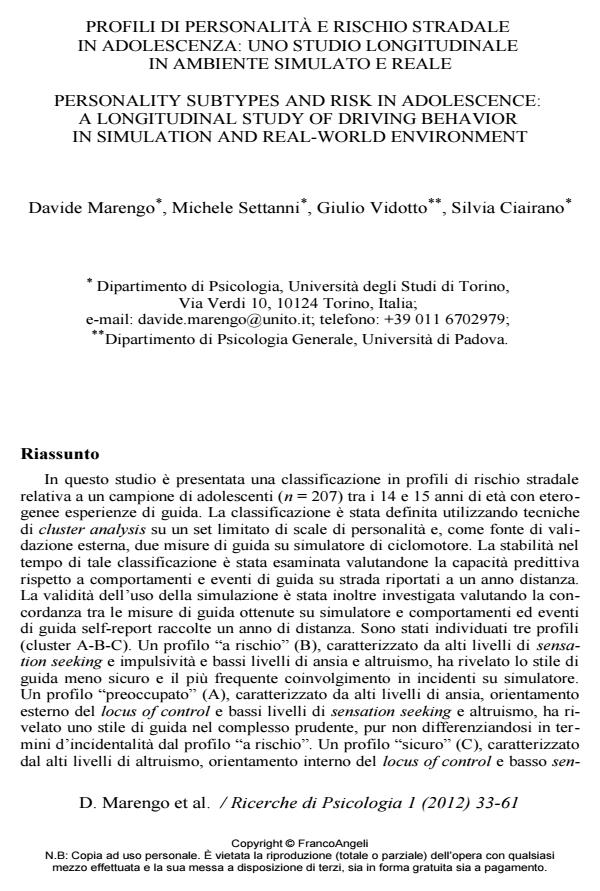Profili di personalità e rischio stradale in adolescenza: uno studio longitudinale in ambiente simulato e reale
Titolo Rivista RICERCHE DI PSICOLOGIA
Autori/Curatori Davide Marengo, Michele Settanni, Giulio Vidotto, Silvia Ciairano
Anno di pubblicazione 2013 Fascicolo 2012/1
Lingua Italiano Numero pagine 29 P. 33-61 Dimensione file 722 KB
DOI 10.3280/RIP2012-001003
Il DOI è il codice a barre della proprietà intellettuale: per saperne di più
clicca qui
Qui sotto puoi vedere in anteprima la prima pagina di questo articolo.
Se questo articolo ti interessa, lo puoi acquistare (e scaricare in formato pdf) seguendo le facili indicazioni per acquistare il download credit. Acquista Download Credits per scaricare questo Articolo in formato PDF

FrancoAngeli è membro della Publishers International Linking Association, Inc (PILA)associazione indipendente e non profit per facilitare (attraverso i servizi tecnologici implementati da CrossRef.org) l’accesso degli studiosi ai contenuti digitali nelle pubblicazioni professionali e scientifiche
In questo studio e presentata una classificazione in profili di rischio stradale relativa a un campione di adolescenti (n = 207) tra i 14 e 15 anni di eta con eterogenee esperienze di guida. La classificazione e stata definita utilizzando tecniche di cluster analysis su un set limitato di scale di personalita e, come fonte di validazione esterna, due misure di guida su simulatore di ciclomotore. La stabilita nel tempo di tale classificazione e stata esaminata valutandone la capacita predittiva rispetto a comportamenti e eventi di guida su strada riportati a un anno distanza. La validita dell’uso della simulazione e stata inoltre investigata valutando la concordanza tra le misure di guida ottenute su simulatore e comportamenti ed eventi di guida self-report raccolte un anno di distanza. Sono stati individuati tre profili (cluster A-B-C). Un profilo "a rischio" (B), caratterizzato da alti livelli di sensation seeking e impulsivita e bassi livelli di ansia e altruismo, ha rivelato lo stile di guida meno sicuro e il piu frequente coinvolgimento in incidenti su simulatore. Un profilo "preoccupato" (A), caratterizzato da alti livelli di ansia, orientamento esterno del locus of control e bassi livelli di sensation seeking e altruismo, ha rivelato uno stile di guida nel complesso prudente, pur non differenziandosi in termini d’incidentalita dal profilo "a rischio". Un profilo "sicuro" (C), caratterizzato dal alti livelli di altruismo, orientamento interno del locus of control e basso sen sation seeking, ha dimostrato lo stile di guida piu sicuro e il piu basso coinvolgimento in incidenti su simulatore. I dati riguardanti la guida in ambiente reale raccolti a un anno di distanza hanno nel complesso confermato le differenze in termini di rischio stradale osservate tra i profili rispetto alla guida su simulatore. La buona concordanza osservata in questo studio tra misure di guida su simulatore e comportamenti ed eventi di guida in ambiente reale rappresenta un elemento a supporto della validita del simulatore come strumento per la misurazione di comportamenti di guida.
Parole chiave:Guida pericolosa, Adolescenza, Simulazione di guida, Profili di personalita, Cluster analysis.
Davide Marengo, Michele Settanni, Giulio Vidotto, Silvia Ciairano, Profili di personalità e rischio stradale in adolescenza: uno studio longitudinale in ambiente simulato e reale in "RICERCHE DI PSICOLOGIA " 1/2012, pp 33-61, DOI: 10.3280/RIP2012-001003